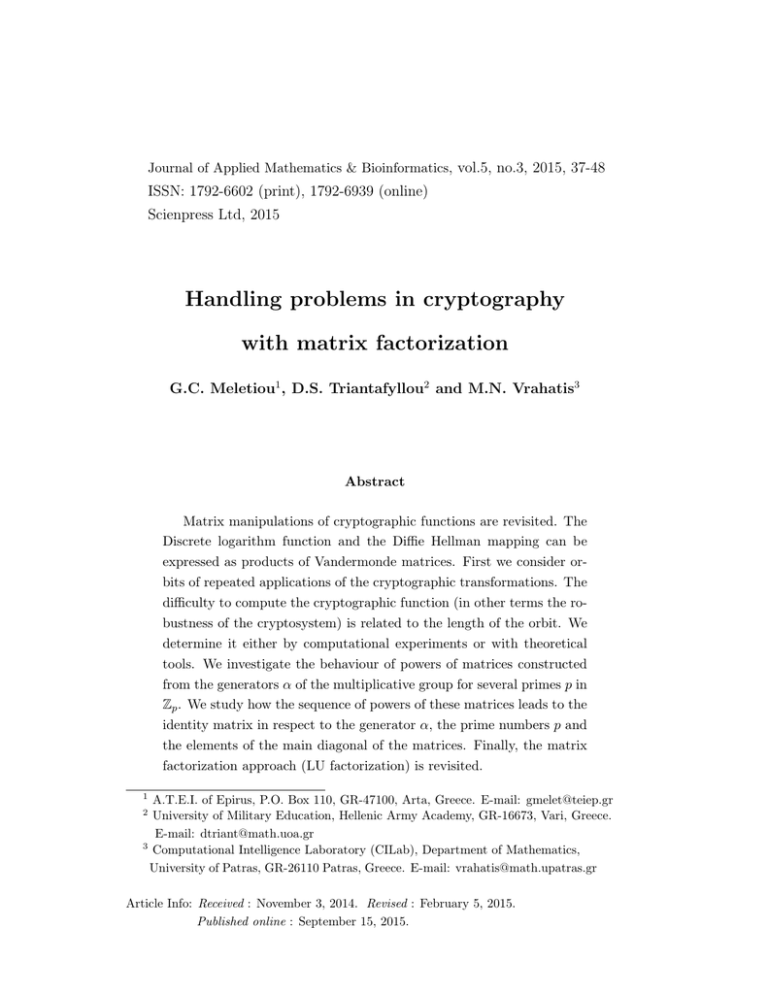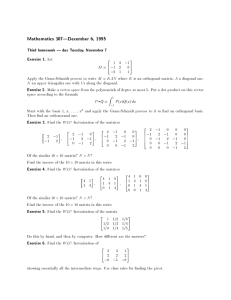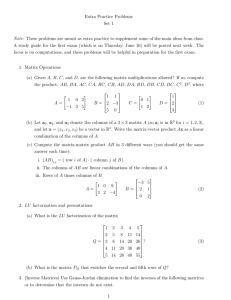Handling problems in cryptography with matrix factorization
advertisement

Journal of Applied Mathematics & Bioinformatics, vol.5, no.3, 2015, 37-48
ISSN: 1792-6602 (print), 1792-6939 (online)
Scienpress Ltd, 2015
Handling problems in cryptography
with matrix factorization
G.C. Meletiou1 , D.S. Triantafyllou2 and M.N. Vrahatis3
Abstract
Matrix manipulations of cryptographic functions are revisited. The
Discrete logarithm function and the Diffie Hellman mapping can be
expressed as products of Vandermonde matrices. First we consider orbits of repeated applications of the cryptographic transformations. The
difficulty to compute the cryptographic function (in other terms the robustness of the cryptosystem) is related to the length of the orbit. We
determine it either by computational experiments or with theoretical
tools. We investigate the behaviour of powers of matrices constructed
from the generators α of the multiplicative group for several primes p in
Zp . We study how the sequence of powers of these matrices leads to the
identity matrix in respect to the generator α, the prime numbers p and
the elements of the main diagonal of the matrices. Finally, the matrix
factorization approach (LU factorization) is revisited.
1
A.T.E.I. of Epirus, P.O. Box 110, GR-47100, Arta, Greece. E-mail: gmelet@teiep.gr
University of Military Education, Hellenic Army Academy, GR-16673, Vari, Greece.
E-mail: dtriant@math.uoa.gr
3
Computational Intelligence Laboratory (CILab), Department of Mathematics,
University of Patras, GR-26110 Patras, Greece. E-mail: vrahatis@math.upatras.gr
2
Article Info: Received : November 3, 2014. Revised : February 5, 2015.
Published online : September 15, 2015.
38
Handling problems in cryptography with matrix factorization
Mathematics Subject Classification: 94A60; 11T71; 68P25; 11T55; 65T50;
41A05; 41A10; 92B20; 82C32
Keywords: LU factorization; matrix triangularization; encryption; decryption; orbit
1
Introduction
In recent cryptographic research the approach of matrix transformations
has been used. The LU factorization (also called LU decomposition) has been
applied in various cryptographic schemes. Factorizing the matrix A as A =
L · U is computationally feasible, however reconstructing the initial matrix A
knowing only the matrix U or only the matrix L is an NP-hard problem [3].
The matrix A can be used for the representation of an image, a diagram, or a
data table, etc. The main idea is to factorize A in order to achieve availability,
persistence, integrity, and confidentiality of the information [16]. The LU
decomposition has been used in key pre-distribution schemes [1]. Users are
represented as nodes since applications of Distributed Sensor Networks are
concerned. Each node corresponds to the i-th row and the i-th column of a
symmetric matrix A = (Aij )16i,j6n and the entry Aij = Aji is the symmetric
(session) key between the i-th and the j-th user. The matrix A is factorized
as A = L · U . The i-th row of L is kept secret by the i-th user, a kind of
private key, while the i-th column of U plays the role of the public key. Users
i and j exchange their columns and compute Aij and Aji respectively which
coincide since A is symmetric. Of course the aforementioned scheme requires
the participation of a dealer (central authority). In some similar schemes LU
0
decomposition is replaced by L · D · U decomposition [2, 8].
In [14, 15] Bilateral Remote User Authentication Schemes have been proposed based on LU decomposition. A user is authenticated from a central
authentication server. The central authority generates a symmetric square
matrix A and assigns an entry of the form Aij = Aji for each user and matrix
A is factorized as A = L · U and a smart card is issued to each user. The information which is contained on the card includes the i-th column of U , key Aij ,
j in encrypted form and the identity of the user. The main idea is to derive
authentication by comparing Aij and Aji since A is symmetric. In improved
39
G.C. Meletiou, D.S. Triantafyllou and M.N. Vrahatis
versions of the aforementioned schemes anonymity of the users is guaranteed
[9, 17].
In the paper at hand we investigate the powers of matrices related to
cryptographic transformations. The matrices represent the discrete logarithm
function and they are derived from the interpolation formula. The powers of
matrices represent the multiple discrete logarithm. The paper is organized
as follows. In Section 2, the required definitions and mathematical tools as
well as the LU factorization scheme are presented. In Section 3, the proposed
algorithms are numerically implemented and the results are summarized in
tables and figures. Finally, in Section 4, a synopsis and concluding remarks
are presented.
2
The Discrete Logarithm function and matrix factorizations
In this section, we present formulas for the polynomial interpolation of
the discrete logarithm and the multiple discrete logarithm function. The LU
factorization algorithm is also developed.
Definition 2.1. Let
A = (Aij )16i,j6p−1 =
−1
ai·j
,
16i,j6p−1
be a (p − 1) × (p − 1) matrix with p prime and a ∈ Zp , where a is a generator
of the multiplicative group.
Remark 2.2. The matrix A is invertible.
Proposition 2.3. [10, 11] The product
h
1 2 ... p − 1
i
·A·
x
x2
..
.
xp−1
is the Lagrange interpolation polynomial for the Discrete Logarithm function,
thus
40
Handling problems in cryptography with matrix factorization
loga x =
h
i
1 2 ... p − 1
Definition 2.4. Let N be a
following form
1
2
2
1
22
N = .
..
.
..
p−1
p−1
1
2
·A·
x
x2
..
.
xp−1
X
p−2 xj
=
, x 6= 0.
j
j=1 1 − a
(p − 1) × (p − 1) matrix with p prime of the
...
...
...
p−1
(p − 1)2
..
.
. . . (p − 1)p−1
∈ Z(p−1)×(p−1)
.
p
Remark 2.5. The matrix N is invertible.
Proposition 2.6. [12] Suppose that loga x = c, then it holds that
h
c c
2
... c
p−1
i>
=N ·A·
h
x x
2
... x
p−1
i>
.
If d is the multiple discrete logarithm of x with multiplicity k, then it holds
that
i>
i>
h
h
= (N · A)k · x x2 . . . xp−1
d d2 . . . dp−1
and
d=
h
1 2 ... p − 1
i
· (N · A)k ·
h
x x2 . . . xp−1
i>
.
The set {(N · A), (N · A)2 , . . . , (N · A)j , . . .} determines the orbit of the
element (N · A). The length of the orbit is the minimum positive integer k
for which (N · A)k = I, where I is the identity matrix. In other terms k is
the order of the element (N · A). According to [5] the value of k has to be
very large. Our computational experiments with small primes verify it. It
is profound that (N · A)−1 is the transformation of the discrete exponential
function; exponentiation modulo a prime is computable (square and multiply
algorithm). Therefore the order of (N · A) has to be high since computing
discrete logarithms and multiple discrete logarithms is infeasible.
The aim of the paper at hand is the extraction of conclusions concerning
the orbit of (N · A) for various values of the prime p and the generator a. The
G.C. Meletiou, D.S. Triantafyllou and M.N. Vrahatis
41
highest the order the hardest is to compute the discrete logarithm function,
therefore the safer the encoding.
Another scope of the paper is the factorization of (N · A)i , i = 1, 2, . . . , k
through the LU decomposition in order to compare the diagonal elements of
U with the diagonal elements of I (the ones).
We elaborate two real valued functions for the matrix:
1. the quasideterminant which is obtained by the product of all diagonal
elements of U considered as nonnegative integers less than p,
2. the quasinorm which is the Euclidean norm of the diagonal elements.
Then we investigate possible “convergence” of these functions to 1.
In our approach we apply the LU factorization of a matrix A which is
briefly presented in the following paragraphs.
The given matrix A is factorized to a lower triangular matrix L with ones
in its main diagonal and the multipliers in the entries below the diagonal and
to an upper triangular matrix U , such that A = L · U . Since the computations
are performed in Zp , there are no floating point errors and thus there is no
need of using pivoting.
The LU Factorization algorithm can be given as follows [6, 7]:
Algorithm of the LU Factorization:
for k = 1 : p − 1
mik = Aik /Akk , i = k + 1 : m
Aij = Aij − mik Akj , i = k + 1 : m, j = k + 1 : n
Numerical Complexity: The required floating point operations of the LU
factorization of a (p − 1) × (p − 1) matrix is O (p − 1)3 /3 .
3
Numerical implementation
In this section we calculate numerically the orbit and the order of the
element (N · A). In the following tables we present the results of the computed
42
Handling problems in cryptography with matrix factorization
orders for various values of the prime p and the generator a of the multiplicative
group of the field.
Table 1: k (minimum power k: (N · A)k = I), α (generator), p=47
α
5
11
13
19
23
29
31
41
43
k
96 378 3036 136 546 144 150 3003 1170
Table 2: k (minimum power k: (N · A)k = I), α (generator), p=73
α
k
5
11
13
29
31
47
53
59
1326 2720 1830 210 70 918 9020 3570
Table 3: k (minimum power k: (N · A)k = I), α (generator), p=101
α
2
3
7
11
29
53
59
61
67
73
83
89
k 46200 7110 2156 33726 440572 460 4830 4950 1020 1998 90 1104
As it is shown in Tables 1, 2 and 3, the order of the element (N · A) is at
least of order of p, thus the encoding is safe. More precisely, in Table 3, for
p = 101 and generator α = 29 the order is 440572 which is significant greater
than p = 101 enforcing the safety.
Next, we perform LU factorizations to (N · A)i , i = 1, 2, . . . , k. We obtain
two sequences, the sequence of the quasideterminants and the sequence of the
quasinorms. If there was any kind of convergence of the sequence of ((N · A)i ),
i = 1, 2, . . . , (order − 1) to I = (N · A)order , then every element of the main
diagonal of (N ·A)i should converge to 1. Thus, the quasinorm of these elements
and the quasideterminant of (N · A)i computed in R should converge to 1.
G.C. Meletiou, D.S. Triantafyllou and M.N. Vrahatis
43
Implementing several examples for various primes p and all of their generators
α we lead to the result that there is no relationship between them. Actually,
there is a significant difference of the order of the computed quasideterminants
and quasinorms of all the powers (N · A)i , i = 1, 2, . . . , (order − 1) with the
quasideterminant and the quasinorm of I = (N · A)order which is equal to 1.
Figure 1: Quasideterminants of (N · A)i , i = 1, 2, . . . , order, p = 47, α = 41
Figure 2: Quasideterminants of (N · A)i , i = 1, 2, . . . , order, p = 71, α = 53
44
Handling problems in cryptography with matrix factorization
Figure 3: Quasideterminants of (N · A)i , i = 1, 2, . . . , order, p = 101, α = 29
In Figures 1, 2 and 3, the quasideterminants of (N · A)i , i = 1, 2, . . . , order
are presented graphically. We used various values of p and α. Specifically
in Figure 1 we used the values p = 47 and α = 41, in Figure 2 the values
p = 73 and α = 53 while in Figure 3 we used the values p = 101 and α =
29. The minimum quasideterminants are of high order (1074 1 (Figure 1),
10119 (Figure 2) and (10193 1 (Figure 3)). Only the last one (the one that
corresponds to (N ·A)order = I is equal to 1. Thus, there is not any convergence
to 1 for the quasideterminants of the powers of (N · A) proving experimentally
that the encoding is safe. The orbits are of order of 3 · 103 1, 9 · 103 1
and 4.4 · 105 1 respectively.
Finally, we investigate the relationship between the quasinorm of the diagonal entries of (N · A)i , for i = 1, 2, . . . , k with the quasinorm of the diagonal
entries of (N · A)k = I. Again, experimentally is shown that there is not any
relation between them (Figures 4,5 and 6).
4
Synopsis and concluding remarks
Initially in the paper at hand, we made a brief survey of earlier schemes
based on matrix factorization (decomposition). The LU factorization has been
applied to many schemes since reconstructing the original matrix from one
G.C. Meletiou, D.S. Triantafyllou and M.N. Vrahatis
45
Figure 4: Quasinorms of (N · A)i , i = 1, 2, . . . , order, p = 47, α = 41
Figure 5: Quasinorms of (N · A)i , i = 1, 2, . . . , order, p = 73, α = 53
of the factors is a NP hard problem. We studied repeated applications of
cryptographic functions extending the employment of matrices. We elaborated
powers of matrices in order to compute the length of the orbits and to relate
it to the robustness of a scheme. A number of computational experiments
verified previous theoretical results related to the Multiple Discrete Logarithm
function. The orbits of the matrices were of the same order of there size, thus,
the encryption is safe. The quasideterminants and the entries of the main
46
Handling problems in cryptography with matrix factorization
Figure 6: Quasinorms of (N · A)i , i = 1, 2, . . . , order, p = 101, α = 29
diagonal of the powers of the matrices do not converge smoothly to those of I
(which is the initial matrix powered to its order), enforcing the encoding since
there is no relationship between them.
The study of other factorizations in order to achieve better representations
of cryptographic functions and facing the computational equivalence of the
discrete logarithm and the Diffie Hellman problem are open topics for future
work.
References
[1] Sung Jin Choi and Hee Yong Youn, An Efficient Key Pre-distribution
Scheme for Secure Distributed Sensor Networks, EUC Workshops 2005,
LNCS 3823, (2005), 1088–1097.
[2] Sung Jin Choi and Hee Yong Youn, MKPS, A Multi-level Key Predistribution Scheme for Secure Wireless Sensor Networks, HumanComputer Interaction, Part II, HCII 2007, LNCS 4551, (2007), 808–817.
[3] Sung Jin Choi and Hee Yong Youn, A Novel Data Encryption and Distribution Approach for High Security and Availability Using LU Decompo-
G.C. Meletiou, D.S. Triantafyllou and M.N. Vrahatis
47
sition, LNCS, 3046, (2004), 637–646.
[4] W. Diffie and M. Hellman, New directions in cryptography, IEEE Trans.
Inf. Th., 22(6), (1976), 644–654.
[5] L. Glebsky and I. Shparlinski, Short Cycles in Repeated Exponentiation
Modulo a Prime, Des. Cod. Crypt., 56(1), (2009), 35–42.
[6] B.N. Datta, Numerical Linear Algebra and Applications, Second Edition,
SIAM, United States of America, 2010.
[7] G.H. Golub and C.F. van Loan, Matrix Computations, Third Edition, The
John Hopkins Univercity Press, Baltimore, 1996.
[8] S. Kumar and D. Dohare, Efficient Key Distribution Schemes for Wireless
Sensor Networks Using LDU Composition of Symmetric Matrices, Communications in Computer and Information Science, 197, (2011), 343–357.
[9] Xiong Li, Jianwei Niu, Muhammad Khurram Khan and Zhibo Wang,
Applying LU Decomposition of Matrices to Design Anonymity Bilateral
Remote User Authentication Scheme, Mathematical Problems in Engineering, 2013, (2013), 1–10, Article ID 910409.
[10] G.C. Meletiou, Explicit form for the discrete logarithm over the field
GF(p,k), Archivum Mathematicum, 29, (1993), 25–28.
[11] G.C. Meletiou and G. Mullen, A note on Discrete Logarithms in finite
fields, A.A.E.C.C., 3, (1992), 75–79.
[12] G.C. Meletiou, E.C. Laskari, D.K. Tasoulis and M.N. Vrahatis, Matrix
representations of Cryptographic Functions, Journal of Applied Mathematics and Bioinformatics, 3(1), (2013), 205–213.
[13] G.C. Meletiou and A. Winterhof, Interpolation of the Double Discrete
Logarithm, LNCS, 5130, (2008), 1–10.
[14] A.S.K. Pathan and C.S. Hong, An efficient bilateral remote user authentication scheme with smart cards, Proceedings of the 33rd Korea Information Science Society Fall Conference, 33(2)(D), (October, 2006), 132–134.
48
Handling problems in cryptography with matrix factorization
[15] A.S.K. Pathan, C.S. Hong and T. Suda, A novel and efficient bilateral remote user authentication scheme using smart cards, Proceedings of
the IEEE International Conference on Consumer Electronics, (January,
2007), 1–2.
[16] D.S. Triantafyllou, Numerical Linear Algebra methods in Data Encoding
and Decoding, Journal of Applied Mathematics and Bioinformatics, 3(1),
(2013), 193–203.
[17] H.R. Tseng, R.H. Jan and W. Yang, A bilateral remote user authentication scheme that preserves user anonymity, Security and Communication
Networks, 1(4), (2008), 301–308.
[18] A. Winterhof, A note on the interpolation of the Diffie-Hellman mapping,
Bull. Austral. Math. Soc., 64(3), (2001), 475–477.





